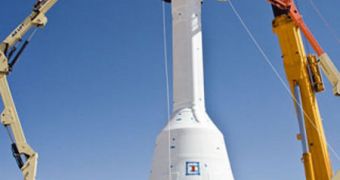Even though if the American space agency has yet to decide the faith of its manned space exploration plans, Project Constellation is continuing onwards undisturbed, officials at NASA say.
Even if the plan set forth by US President Barack Obama and NASA Administrator Charles Bolden get approved, the agency will not stop working on Constellation until the end of this year.
The plans call for more than $6 billion to be alloted to the private space industry, for the development of spacecraft capable of ferrying astronauts to the International Space Station (ISS) within 5 years.
But a bill approved by Senate a couple of weeks ago is proposing that the private space sector get only minimal aid, and that the US government and NASA develop a new heavy-lift rocket starting this year.
The new plans, which have yet to enter effect, also call for an additional shuttle flight, beyond that of Endeavor. The last Space Shuttle Program sortie is currently scheduled to take place in February 2011.
Even with all of this confusion, NASA and its contractors are continuing work on the ARES I delivery system and the Orion Crew Exploration Vehicle.
The former is designed to become the United States' next main rocket for delivering astronauts to low-Earth orbit (LEO). Its goal would be to carry Orion.
The manned spacecraft represents a return to the earlier space capsule concepts that NASA used for the Apollo mission. The Orion would be capable of carrying up to four astronauts to the Moon and back.
The whole purpose of Project Constellation is to put American astronauts back on the Moon by 2020.
One of the main contractors that NASA is working with on making this a reality is Lockheed Martin, one of the top defense and technology corporations in the world.
“We have been on contract to execute the 2010 plan, and there are a lot of accomplishments and milestones in that plan,” explains the Orion deputy program manager at Lockheed, Larry Price.
He explains that engineering teams at the company will continue work on their end of the Project until the beginning of 2011, when currently-sanctioned funds run out.
“It is a disturbance, people wonder what's happening,” Price adds, referring to the fact that the political uncertainty is affecting the Project.
“But people are doing this because they are passionate about it. It is exciting, inspiring work to be building a human spacecraft to go beyond low Earth orbit,” he concludes, quoted by Space.

 14 DAY TRIAL //
14 DAY TRIAL //